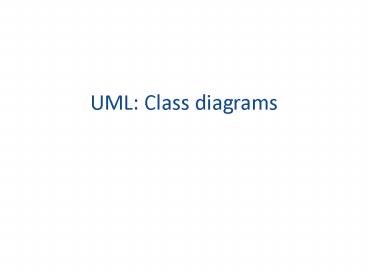UML: Class diagrams - PowerPoint PPT Presentation
1 / 27
Title:
UML: Class diagrams
Description:
UML: Class diagrams Intended learning outcomes Define structural (static) models Implement modelling methodology Identify and use standard UML notation for structural ... – PowerPoint PPT presentation
Number of Views:225
Avg rating:3.0/5.0
Title: UML: Class diagrams
1
UML Class diagrams
2
Intended learning outcomes
- Define structural (static) models
- Implement modelling methodology
- Identify and use standard UML notation for
structural modelling - Create simple class diagrams
- Identify opportunities for refinement
3
Where we are
- Develop System Request
- Understand As-Is system
- Identify improvement opportunities
- Develop the To-Be system concept
- Develop Use Cases
- Develop Structural Model
- The Class Diagram
4
Structural Modeling
5
Key Ideas
- A structural (static) or conceptual model
describes the structure of the data that supports
the business processes in an organization. - The structure of data used in the system is
represented through CRC cards, class diagrams,
and object diagrams.
6
Elements of a CRC card
7
STRUCTURAL MODELS
8
Purpose of Structural Models
- Reduce the semantic gap between the real world
and the world of software - Create a vocabulary for analysts and users
- Represent things, ideas, and concepts of
importance in the application domain
9
Classes
- Templates for creating instances or objects
- Concrete
- Abstract
- Typical examples
- Application domain, user interface, data
structure, file structure, operating environment,
document, and multimedia classes
10
Attributes
- Units of information relevant to the description
of the class - Only attributes important to the task should be
included
11
Operations
- Action that instances/objects can take
- Focus on relevant problem-specific operations (at
this point)
12
Relationships
- Generalization
- Enables inheritance of attributes and operations
- Aggregation
- Relates parts to wholes
- Association
- Miscellaneous relationships between classes
13
CLASS DIAGRAMS
14
Example Conceptual Class Diagram
15
Class Diagram Syntax
16
The Class Diagram
- Use of Natural Language
- Discard inappropriate candidates
- From the nouns in the problem statement
- Eliminate the
- redundant
- irrelevant - those unrelated to the problem
- Vague - ill-defined boundary, very broad in scope
- attributes - things that describe an object
- operations - things that manipulate objects
- implementation constructs - extraneous to real
world must be eliminated from analysis model,
needed during design, but not now.
17
Example problem statement for library automation
system
- Design the software to support the operation of a
public library or group of libraries. The system
has a number of stations and PCs for customer
transactions. These stations are operated by
library employees. When a book is borrowed, the
identification card of the client is read. Next,
the stations barcode reader reads the books
code. When a book is returned, the identification
card is not needed and only the books code needs
to be read.
18
Object modelling identifying classes
- Library automation system potential object list
19
Object modelling keeping the right classes
- Object
- Elimination reason
20
Object Modeling - The Good Classes
21
Object modelling data dictionary
- Prepare a data dictionary/ description of each
class - Station a terminal linked to a central computer
operated by employees with a barcode reader.
22
Identify Associations
- Associations correspond to verbs in the problem
statement - Association any dependency between two classes
- From the problem statement
- Employee operates station
- From tacit knowledge
- Library owns computer
23
Initial class diagram
24
Further Specify the semantics of associations
- Include Multiplicity
- Qualifier or Qualified Associations
- Usually a name identifies an object within some
context most names are not globally unique. The
context combines with the name to uniquely
identify the object. - A Qualifier distinguishes objects on the many
side of an association. For example, a qualifier
bankcode could be added to distinguish the
different banks in a consortium. Each cash card
needs a bank code so that transactions can be
directed to the appropriate bank.
25
Identifying Attributes and operations
- Attributes
- Properties of an individual object
- Usually possessive phrases e.g. the colour of the
car - Identify from the problem description and domain
knowledge - Operations
- Define ways in which objects interact
26
Identifying attributes
27
Summary
- Class and object diagrams show the underlying
structure of an object-oriented system. - Constructing the structural model is an iterative
process involving textual analysis,
brainstorming objects, role playing, creating the
diagrams, and incorporating useful patterns.































